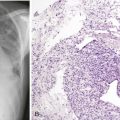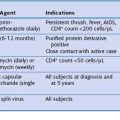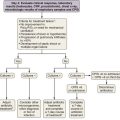Chapter 33 Noninvasive Mechanical Ventilation
Indications for Implementation of Noninvasive Ventilation
• Poor alveolar gas exchange level (as indicated by PaO2/FIO2 less than 200 mm Hg)
• Ventilatory pump failure with hypercapnia and respiratory acidosis (PaCO2 greater than 45 mm Hg and pH below 7.35)
• Severe dyspnea accompanied by use of accessory respiratory muscles
• Tachypnea (with respiratory rate greater than 24 breaths/minute)
Equipment
Ventilators
1. Typical ICU ventilators, powered by compressed gas, usually from wall outlets, and interfaced to the patient exclusively by means of a double circuit, with separate inspiratory and expiratory limbs. These systems are equipped with a screen to allow complete monitoring of ventilatory parameters and graphic display of flow, volume, and pressure curves. They typically are used for invasive ventilation. When set for pressure ventilation, they function on the PSV/PEEP algorithm, in which, as mentioned, the PSV level is superimposed on the PEEP, with total inspiratory pressure thus resulting from the sum of PSV and PEEP.
2. Portable home ventilators (bilevel ventilators), electrically powered and providing only a single circuit for both inspiration and expiration. These machines are used exclusively for noninvasive ventilatory support. They function on the IPAP/EPAP algorithm, in which the inspiratory positive airway pressure (IPAP) is not superimposed on the expiratory pressure (EPAP).
3. “Hybrid” ventilators, usually powered by electricity, allowing both single- and double-circuit options. They use the PSV/PEEP algorithm. They can be used for both invasive as well as noninvasive ventilation.
Clinical Indications
Ambrosino N, Nava S, Torbiki A, et al. Haemodynamic effect of pressure support and PEEP ventilation by nasal route in patients with stable chronic obstructive pulmonary disease. Thorax. 1993;48:523–528.
Antonelli A, Conti G, Esquinas A, et al. A multiple-center survey of the use in clinical practice of non invasive ventilation as a first line intervention for acute respiratory distress syndrome. Crit Care Med. 2007;35:18–25.
Antonelli M, Conti G, Rocco M, et al. A comparison of non-invasive positive pressure ventilation and conventional mechanical ventilation in patients with acute respiratory failure. N Engl J Med. 1998;339:429–435.
Auriant I, Jallot A, Hervé P, et al. Noninvasive ventilation reduces mortality in acute respiratory failure following lung resection. Am J Respir Crit Care Med. 2002;164:1231–1235.
Beltrame F, Lucangelo U, Gregori D, Gregoretti C. Noninvasive positive pressure ventilation in trauma patients with acute respiratory failure. Monaldi Arch Chest Dis. 1999;54:109–114.
Bott J, Carrol MP, Conway JH, et al. Randomised controlled trial of nasal ventilation in acute ventilatory failure due to chronic obstructive airways disease. Lancet. 1993;341:1555–1557.
Brochard L, Isabey D, Piquet J, et al. Reversal of acute exacerbations of chronic obstructive lung disease by inspiratory assistance with a face mask. N Engl J Med. 1990;323:1523–1530.
Burns KE, Adhikari NK, Keenan SP, Meade M. Use of non-invasive ventilation to wean critically ill adults off invasive ventilation: meta-analysis and systematic review. BMJ. 2009;338:b1574.
Celikel T, Sungur M, Cayhan B, Karakurt S. Comparison of noninvasive positive pressure ventilation with standard medical therapy in hypercapnic acute respiratory failure. Chest. 1998;114:1636–1642.
Cheung TM, Yam LY, So LK, et al. Effectiveness of non-invasive positive pressure ventilation in the treatment of acute respiratory failure in severe acute respiratory syndrome. Chest. 2004;126:670–674.
Collins SP, Mielniczuk LM, Whittingham HA, et al. The use of non-invasive ventilation in emergency department patients with acute cardiogenic pulmonary edema: a systematic review. Ann Emerg Med. 2006;48:260–269.
Confalonieri M, Potena A, Carbone G, et al. Acute respiratory failure in patients with severe community-acquired pneumonia. A prospective randomized evaluation of non invasive ventilation. Am J Respir Crit Care Med. 1999;160:1585–1591.
Crimi C, Noto A, Princi P, et al. A European survey of non-invasive ventilation practice. Eur Respir J. 2010;36:362–369.
Diaz O, Iglesia R, Ferrer M, et al. Effects of noninvasive ventilation on pulmonary gas exchange and hemodynamics during acute hypercapnic exacerbations of chronic obstructive pulmonary disease. Am J Respir Crit Care Med. 1997;156:1840–1845.
Dikensoy O, Ikidag B, Filiiz A, Bayram N. Comparison of non-invasive ventilation and standard medical therapy in acute hypercapnic respiratory failure: a randomised controlled trial at a tertiary health centre in SE Turkey. Int J Clin Pract. 2002;56:85–88.
Elliott MW: European Respiratory Society Interactive course on non-invasive positive pressure ventilation: consensus, controversies and new horizons, Hanover, Germany, February 12–14, 2009.
Fauroux B, Burgel PR, Boelle PY, et al. Chronic Respiratory Insufficiency Group of the French National Cystic Fibrosis Federation: Practice of noninvasive ventilation for cystic fibrosis: a nationwide survey in France. Respir Care. 2008;53:1482–1489.
Fernandez R, Blanch LP, Valles J, et al. Pressure support ventilation via face mask in acute respiratory failure in hypercapnic COPD patients. Intensive Care Med. 1993;19:456–461.
Ferrer M, Esquinas A, Arancibia F, et al. Noninvasive ventilation during persistent weaning failure: a randomized controlled trial. Am J Respir Crit Care Med. 2003;168:70–76.
Ferrer M, Valencia M, Carrillo A, et al. Non-invasive ventilation after extubation in hypercapnic patients with chronic respiratory disorders: randomized controlled trial. Lancet. 2009;374:1082–1088.
Ferrer M, Valencia M, Nicolas JM, et al. Early non-invasive ventilation averts extubation failure in patients at risk. A randomized trial. Am J Respir Crit Care Med. 2006;173:164–170.
Fraticelli AT, Lellouche F, et al. Physiological effects of different interfaces during noninvasive mechanical ventilation for acute respiratory failure. Crit Care Med. 2009;37:939–945.
Girault C, Daudenthun I, Chevron V, et al. Noninvasive ventilation as a systematic extubation and weaning technique in acute-on-chronic respiratory failure: a prospective, randomized controlled study. Am J Respir Crit Care Med. 1999;160:86–92.
Gray A, Goodacre S, Newby DE, et al. Noninvasive ventilation in acute cardiogenic pulmonary edema. N Engl J Med. 2008;359:142–151.
Han F, Jiang YY, Zheng JH, et al. Noninvasive positive pressure ventilation treatment for acute respiratory failure in SARS. Sleep Breath. 2004;8:94–106.
Hess DR, Pang JM, Camargo CAJr. A survey of the use of noninvasive ventilation in academic emergency departments in the United States. Respir Care. 2009;54:1306–1312.
Hilbert G, Gruson D, Vargas F, et al. Noninvasive ventilation in immunosuppressed patients with pulmonary infiltrates, fever and acute respiratory failure. N Engl J Med. 2001;344:481–487.
Jaber S, Chanques G, Sebbane M, et al. Noninvasive positive pressure ventilation in patients with respiratory failure due to severe acute pancreatitis. Respiration. 2006;73:166–172.
Joris JL, Sottiaux TM, Chiche JD, et al. Effect of bi-level positive airway pressure (BiPAP) nasal ventilation on the postoperative pulmonary restrictive syndrome in obese patients undergoing gastroplasty. Chest. 1997;111:665–670.
Kallet RH, Diaz JV. The physiologic effects of noninvasive ventilation. Respir Care. 2009;54:102–114.
Kroschinsky F, Weise M, Illmer T, et al. Outcome and prognostic features of intensive care unit treatment in patients with hematological malignancies. Intensive Care Med. 2002;28:1294–1300.
Masip J, Rocha M, Sanchez B, et al. Non invasive ventilation in acute pulmonary edema. Systematic review and meta-analysis. JAMA. 2005;294:3124–3130.
Meduri GU, Conoscenti CC, Menashe P, Nair S. Noninvasive face mask ventilation in patients with acute respiratory failure. Chest. 1989;95:865–870.
Nava S, Ambrosino N, Clini E, et al. Noninvasive mechanical ventilation in the weaning of patients with respiratory failure due to chronic obstructive pulmonary disease. A randomized, controlled trial. Ann Intern Med. 1998;128:721–728.
Nava S, Carbone G, Dibattista N, et al. Noninvasive ventilation in cardiogenic pulmonary edema: a multicenter, randomized trial. Am J Respir Crit Care Med. 2003;168:1432–1437.
Nava S, Grassi M, Fanfulla F, et al. Non-invasive ventilation in elderly patients with acute hypercapnic respiratory failure: a randomised controlled trial. Age Ageing. 2011;40:444–450.
Nava S, Gregoretti C, Fanfulla F, et al. Noninvasive ventilation to prevent respiratory failure after extubation in high risk patients. Crit Care Med. 2005;33:2465–2470.
Navalesi P, Fanfulla F, Frigerio P, et al. Physiologic evaluation of noninvasive mechanical ventilation delivered with three types of masks in patients with hypercapnic respiratory failure. Crit Care Med. 2000;28:1785–1790.
O’Brien G, Criner GJ. Mechanical ventilation as a bridge to lung transplantation. J Heart Lung Transplant. 1999;18:255–265.
Park M, Sangean MC, Volpe MS, et al. Randomized, prospective trial of oxygen, continuous positive airway pressure, and bilevel positive airway pressure by face mask in acute cardiogenic pulmonary edema. Crit Care Med. 2004;32:2407–2415.
Pérez de Llano LA, Golpe R, Ortiz Piquer M, et al. Short-term and long-term effects of nasal intermittent positive pressure ventilation in patients with obesity-hypoventilation syndrome. Chest. 2005;128:587–594.
Peter JV, Moran JL, Phillips-Hughes J, et al. Effect of non-invasive positive pressure ventilation on mortality in patients with acute cardiogenic pulmonary oedema: a meta-analysis. Lancet. 2006;367:1155–1163.
Philip-Joet FF, Paganelli FF, Dutau HL, Saadjan AY. Hemodynamic effect of bilevel nasal positive airway pressure ventilation in patients with heart failure. Respiration. 1999;66:136–143.
Plant PK, Owen JL, Elliot MW. A multicentre randomised controlled trial of the early use of non-invasive ventilation in acute exacerbation of chronic obstructive pulmonary disease on general respiratory wards. Lancet. 2000;335:1931–1935.
Plant PK, Owen JL, Elliott MW. Early use of non-invasive ventilation for acute exacerbations of chronic obstructive pulmonary disease on general respiratory wards: a multicentre randomised controlled trial. Lancet. 2000;355:1931–1935.
Principi T, Pantanetti S, Catani F, et al. Noninvasive continuous positive airway pressure delivered by helmet in hematological malignancy patients with hypoxemic acute respiratory failure. Intensive Care Med. 2004;30:147–150.
Roberts CM, Stone RA, Buckingham RJ, et al Acidosis, non-invasive ventilation and mortality in hospitalised COPD exacerbations. National COPD Resources and Outcome Project implementation group. Thorax. 2011;66:43–48.
Rothaar RC, Epstein SK. Extubation failure: magnitude of the problem, impact on outcomes, and prevention. Curr Opin Crit Care. 2003;9:59–66.
Squadrone V, Coha M, Cerutti E, et al. Continuous positive airway pressure for treatment of postoperative hypoxemia. JAMA. 2005;293:589–595.
Thys F, Roeseler J, Reynaert M, et al. Noninvasive ventilation for acute respiratory failure: a prospective randomised placebo-controlled trial. Eur Respir J. 2002;20:545–555.
Trevisan CE, Vieira SR Noninvasive mechanical ventilation may be useful in treating patients who fail weaning from invasive mechanical ventilation: a randomized clinical trial. Research Group in Mechanical Ventilation Weaning. Crit Care. 2008;12:R51.
Valipour A, Schneider F, Kossler W, et al. Heart rate variability and spontaneous baroflex sequences in supine healthy volunteers subjected to nasal positive airway pressure. J Appl Physiol. 2005;99:2137–2143.
Vianello A, Bevilacqua M, Arcaro G, et al. Non-invasive ventilatory approach to treatment of acute respiratory failure in neuromuscular disorders. A comparison with endotracheal intubation. Intensive Care Med. 2000;26:384–390.
Vignaux L, Vargas F, Roeseler J, et al. Patient-ventilator asynchrony during non-invasive ventilation for acute respiratory failure: a multicenter study. Intensive Care Med. 2009;35:840–846.
Winck JC, Azevedo LF, Costa-Pereira A, et al. Efficacy and safety of non-invasive ventilation in the treatment of acute cardiogenic pulmonary edema—a systematic review and meta-analysis. Crit Care. 2006;10:R69.
Wood KA, Lewis L, Von Harz B, Kollef MH. The use of non-invasive positive pressure ventilation in the emergency department: results of a randomized clinical trial. Chest. 1998;113:1339–1346.







